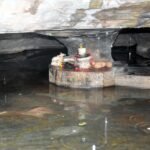
Bhopal (Madhya Pradesh): The autumn afternoon with a whiff of winter was approaching fast with its lengthening shadows. This is the time when the Lalghati or the Red Valley, if it is a holiday, emits an aroma of the past. If the smell of petrol and the noise of traffic do not disperse that antique fragrance, you are bound to feel that you had entered the pages of history.
And the once-forested hillocks clad in red sandstones begin to appear before you – though you know many of its ridges have been razed to build roads. Still, there are some vestiges of the hills lying here and there. The word Lalghati is derived from red sandstone hills that surround the area. Just as you close your physical eyes, the pages of history slowly open up before you and begin to tell the tale of a bloodbath.
How the area was speckled with the blood of soldiers after a fight between the army of the local king and that of Dost Mohammed Khan over capturing Bhopal. Because the area turned blood red after the battle, it is called Lalghati.
A former diplomat of Pakistan Shahryar Khan, who was connected with the Nawab family of Bhopal and born in the city, in a book, the Begums of Bhopal, mentioned the history behind the name of Lalghati. But only a few historians support this claim. Anyway, the fast-approaching afternoon of the present does not remember the twilight of the past.
On the hammocks of Lalghati, stands Gufa Mandir, nearly five kilometres off the Bhopal city. Suddenly, just as you hear the clangs of the temple bells, you are into another story. But don’t forget, to reach the main temple, you have to climb 70 staircases. So, you need strong legs.
No sooner do you reach the door of the temple and have a glimpse of the main deity there, Lord Shiva, than the weariness of climbing so many staircases is over. The place is an embodiment of cave architecture or rock-cut architecture.
Cave architecture is the practice of carving structures out of solid rock, said Indian art historian Percy Brown in Indian Architecture (Buddhist and Hindu periods). It is also known as rock-cut architecture. Nevertheless, whenever you talk about the cave temples, you only talk about Ajanta and Ellora. But Bhopal Gufa Temple has some salient features.
There is no doubt that the caves that house the temple developed millions of years ago, but they remained hidden because of forests and lack of public interest. According to some historians, Lal Ghati was the hunting ground for the Nawabs for a long time. It means wild animals used to roam the forests and hilly tracks.
For the place was a rocky terrain covered with dark deep woods few could dare to go there after day fall just a few years ago. Today’s Gufa Temple was hidden in the abyss of antiquity. Swamy Narayan Das discovered it in 1949 and restored it on April 2, 1965.
The temple surrounded by dark deep woods is worth a visit. Nature’s signature is everywhere besides a gentle breeze, carrying the songs of birds, provides a visitor with a path to mingle with eternity. The temple was cut out of seven natural caves that house the idols of Lord Shiva, Ram Laxman, Hanuman and Goddess Durga.
Water naturally falls through the roof of one of the caves where you can have the glimpse of a Swyambhu Shivlinga. The floor of this cave remains under foot-deep water even in summers. It provides cooling effects to your tired mind and sleep to the aching eyes.
This is the reason why the temple is popular among tourists and locals alike. It is breathtaking. Yet you cannot be there for a long time, for you have miles and miles to go before you sleep in contentment.
So, you suddenly looked at the western vault of the sky: the autumn afternoon was fast taking shelter into the embrace of its eternal bride, the evening. The warbles of winged pipers were slowly fading into the horizon. You, too, get out of the trance that the temple took you into. It was the time to return to the hustle bustle of daily life.

